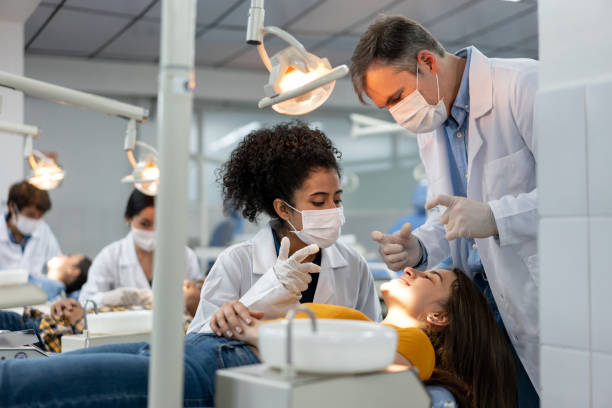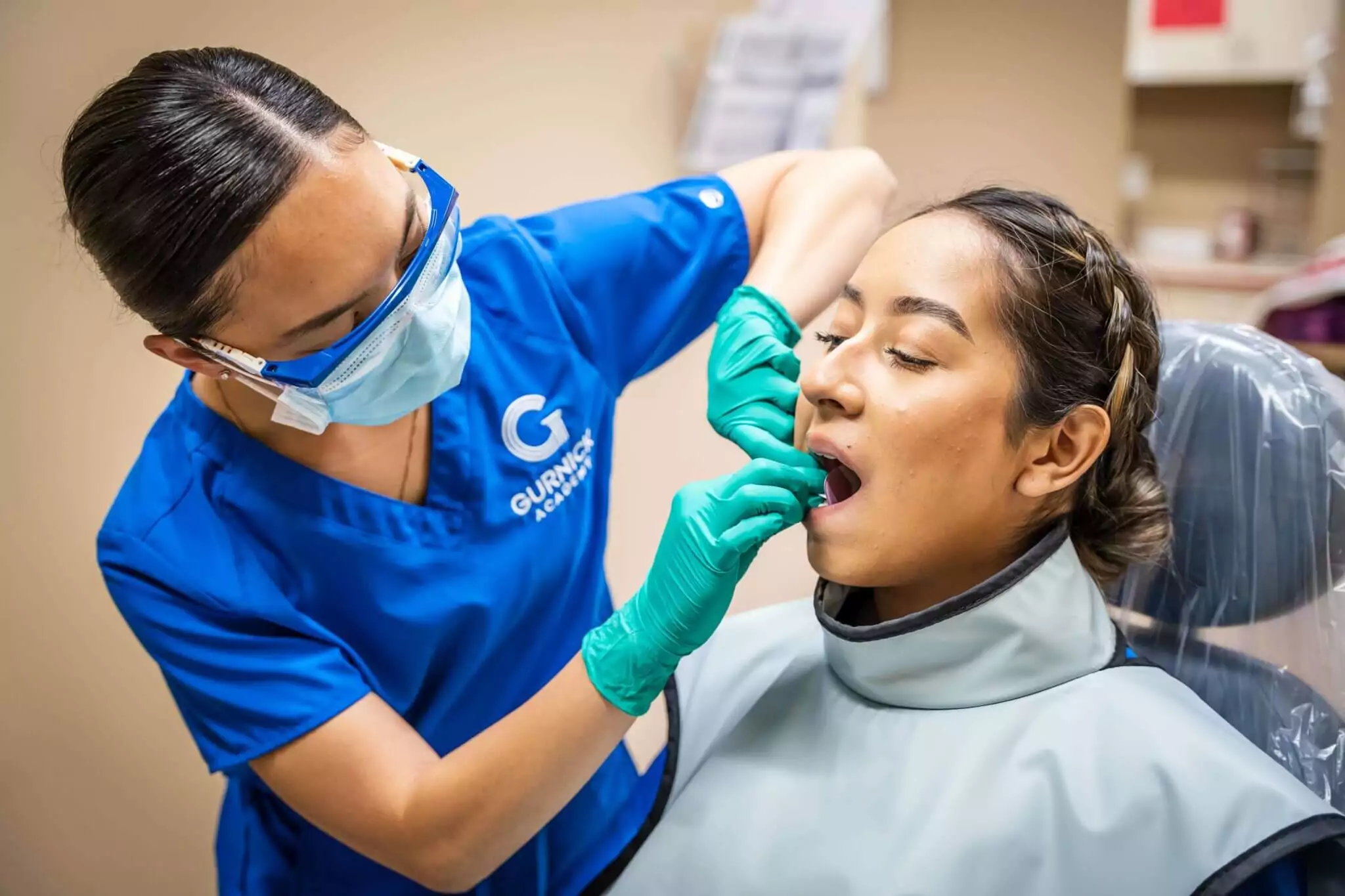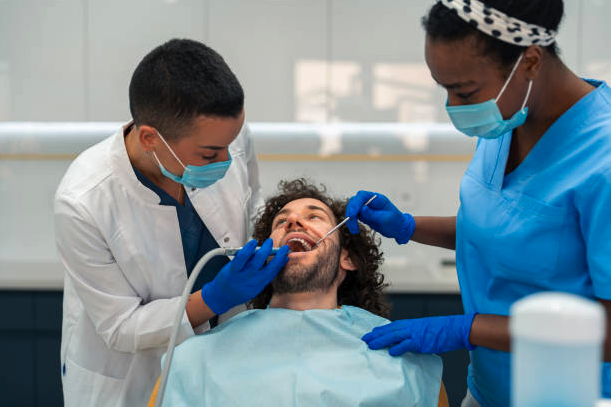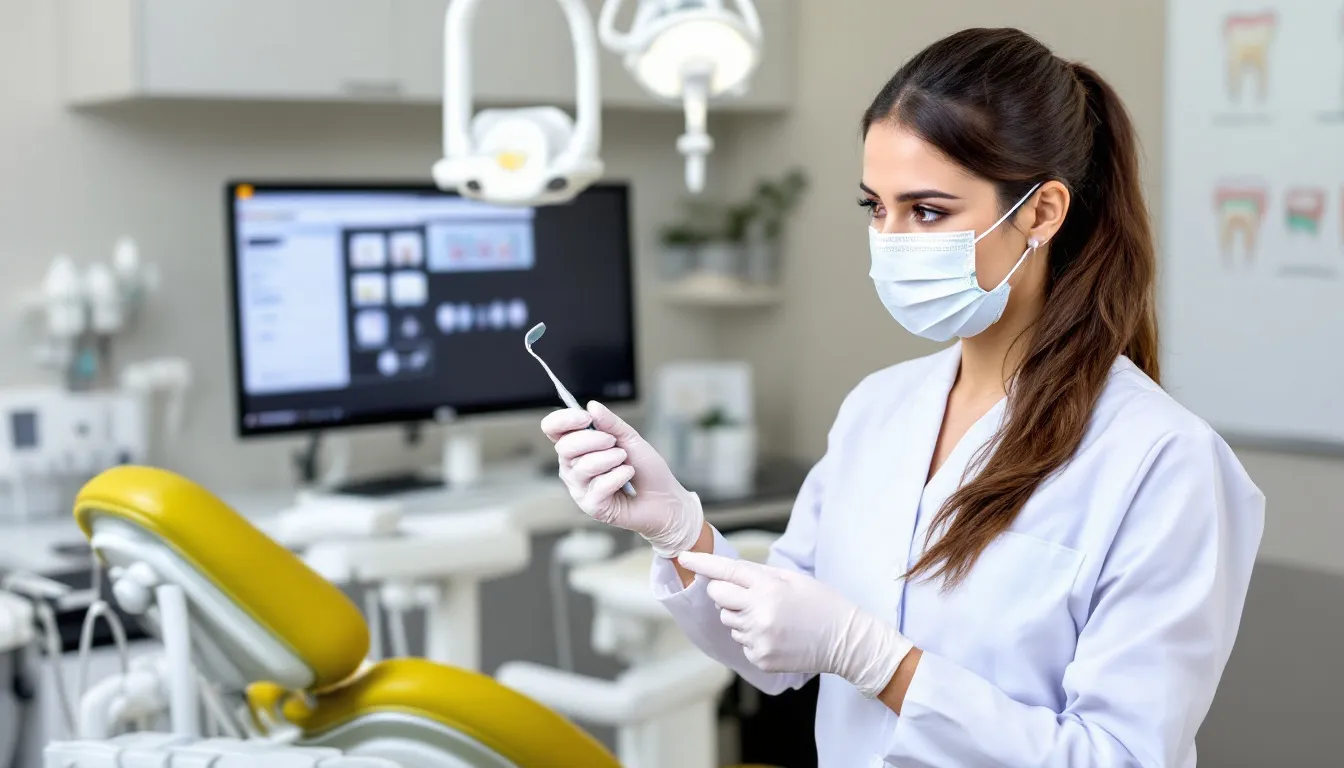Table of contents
Get Started with Kwikly
Get the latest updates, insights, and exclusive content delivered straight to your inbox.
Who This is For:
- Dental assistants who are ready to level up their careers and explore what it takes to become a dental hygienist.
- Students considering both roles and weighing the differences in pay, independence, and career growth.
What You Need to Know
- Dental hygienists make way more money than dental assistants and get to work more independently, which means better chances to grow your career.
- You’ll need at least an associate’s degree, some prerequisite courses, hands-on clinical experience, and additional education beyond what is required for dental assistants to make this happen.
- Platforms like Kwikly give you the flexibility to pick your shifts and get valuable experience while you’re working on your education.
Thinking about moving up from dental assistant to dental hygienist? It's a smart move that'll boost your paycheck, give you more responsibility, and let you work more independently with patients. We'll walk you through exactly how to make this switch, what you need to know about school and certifications, and what's waiting for you on the other side.
Introduction to Dental Careers
Dental careers are a great choice for anyone who’s passionate about helping others and making a real difference in people’s lives. In the dental field, two of the most in-demand roles are dental assistants and dental hygienists. Both positions are essential for keeping dental offices running smoothly and ensuring patients get the best care possible.
Dental assistants are often the first point of contact for patients, preparing patients for dental procedures, sterilizing instruments, and keeping patient records organized. They play a key role in supporting dentists and other dental professionals, making sure every appointment goes off without a hitch. Their work behind the scenes—like handling dental x rays and assisting with administrative tasks—helps create a positive experience for patients and keeps the dental practice efficient.
Dental hygienists, on the other hand, focus more on direct patient care. They’re the ones cleaning teeth, performing dental x rays, and educating patients about oral hygiene and proper brushing and flossing techniques. Dental hygienists are experts in preventive care, helping patients maintain good oral health and avoid future dental problems.
Whether you’re interested in preparing patients for treatment, educating patients about oral health, or taking on more responsibility in patient care, both dental assistants and dental hygienists offer rewarding career paths. In this article, we’ll break down the key differences between these roles, what it takes to move from assistant to dental hygienist, and how you can start preparing for your next step in the dental field.

What Dental Assistants and Dental Hygienists Actually Do
If you’re a dental assistant, you know your job pretty well. You’re the one who: If you have questions about dental tax issues for U.S. professionals and practices, helpful answers are available.
- Supports dentists and hygienists
- Talks with patients and gets them ready
- Helps prep patients for procedures
- Handles the paperwork and admin stuff
- Assists with x-rays
- Jumps in wherever you’re needed
But here’s the thing - you don’t do clinical assessments. You’re the support that ensures the smooth operation of the dental office, and that’s crucial for any dental office.
Dental hygienists? They’re hands-on with patient care. They’re the ones removing plaque, doing cleanings, and checking patients’ mouths. Dental hygienists perform teeth cleanings and provide fluoride treatments as part of preventive care. Unlike assistants, hygienists work pretty independently and get involved in diagnosing issues and teaching patients about oral health. This bigger scope means they have more direct impact on the care of the patient's teeth, kind of like what dentists do.
The big difference between dental assistants and hygienists comes down to clinical responsibilities and how much school you need. Dental assistants can get started pretty quickly, but hygienists need more education - usually an associate degree or more. That’s the trade-off when you’re looking at dental assistant vs dental hygienist.
All that extra training lets hygienists screen for oral diseases and really get into the details of patient education - like showing people the right way to brush and floss. If you’re thinking about making this jump, you need to understand these differences.
Why You Should Make the Switch
Many dental assistants consider or pursue the transition to dental hygienist for better pay and career growth. The biggest reason people move from dental assistant to dental hygienist? Money. Dental hygienists earn around $87,530 a year on average, which is a lot more than the $46,540 that dental assistants typically earn. That pay bump reflects all the extra skills and responsibilities you’ll take on.
But it’s not just about the money. Moving up to dental hygienist opens up tons of career opportunities in the dental field. You can specialize, work in different healthcare settings, or even move into leadership roles at dental practices. And here’s the good news - it’s totally doable. Most people can finish the education and training in about two years after they’ve been working as a dental assistant.
Another big plus? You get way more independence with patient care. Dental assistants usually work under close supervision, but hygienists can do clinical assessments and create personalized care plans for patients. That extra responsibility means you’re making a bigger difference in your patients’ oral health and overall well-being.
Going from dental assistant to dental hygienist isn’t just a career move - it’s a chance to grow both professionally and personally.
School Requirements for Dental Hygienists
To become a dental hygienist, you need specific education - mainly an associate’s degree in dental hygiene. These programs give you both the book knowledge and hands-on skills you’ll need for the job. You can get either an associate or bachelor’s degree, and most associate programs take about three years to finish. Some students choose to pursue a bachelor's degree for advanced qualifications or broader career opportunities.
Before you can even apply to a dental hygiene program, you’ll need to knock out some prerequisite courses. We’re talking anatomy, chemistry, math, and psychology. These foundation courses help you understand the more complex stuff you’ll learn later. Most programs also want you to have a minimum GPA and you’ll need to submit transcripts and proof you’ve done the coursework.
Some schools offer a diploma program in dental hygiene, which provides formal coursework and practical training as an alternative pathway to entering the field.
Clinical procedures are huge in dental hygiene education. You have to complete clinical practice to get that hands-on experience and develop the skills you’ll actually use on the job. During this part, you’ll learn to take vitals, do oral screenings, and use both old-school and digital tech for x-rays and dental imaging. This hands-on training is what really prepares you to work on your own as a hygienist.
One more thing - you must complete an accredited dental hygiene program at a recognized educational institution. Your dental hygiene program has to be an accredited program by a recognized dental accreditation body. Graduating from an accredited program is essential for licensure and ensures the education you’re getting meets industry standards and actually prepares you for the job. Plus, accreditation is usually required for licensure, so it’s a crucial part of your education.

Getting Certified and Licensed
Once you’re done with school, you need to get certified and licensed to work as a dental hygienist. Most states require dental hygienists to be licensed, and may have specific requirements you must meet. You’ll have to pass both the National Board Dental Hygiene Examination and a state-specific clinical exam. The national exam has 350 multiple-choice questions that test the essential knowledge you need for dental practice.
On top of the national exam, state licensing exams might include other tests like jurisprudence exams on state dental laws. Each state has its own licensing requirements, so you need to know what’s required where you want to practice. To apply for a state license, you’ll submit proof of your education along with your exam results to your state dental board, including results from the dental assisting national board.
Keeping your license means ongoing professional development:
- Staying current with continuing education courses
- Keeping up with the latest advances in dental hygiene
- Making sure you’re still providing quality care to your patients
Some states require dental hygienists to complete additional training to administer local anesthesia, which is an important skill for managing patient pain during dental procedures.
The licensing process can be tough, but it’s a critical step in your career path to becoming a successful dental hygienist.
Getting Real-World Experience
Getting practical experience is huge when you’re making the jump from dental assistant to dental hygienist. Clinical training helps you build those people skills you need to earn patients’ trust. During your dental hygiene program and dental assistant program, you’ll work with all kinds of patients, which makes you more adaptable and gets you ready for whatever comes up in a dental practice. A dental assistant program is designed to prepare students for entry-level positions by providing foundational knowledge and hands-on skills.
Hands-on experience means doing real tasks like taking vitals, doing oral screenings, and using advanced cleaning techniques. This practical training is what makes you clinically proficient and ensures you’re ready to handle the responsibilities of being a dental hygienist. You’ll also learn to use both traditional and digital technologies for x-rays and dental imaging, which is a crucial skill you’ll develop during training. Seeking additional training is important for expanding your clinical skills and staying up to date with new procedures and equipment.
If you’ve already worked as a dental assistant, that dental assistant experience can make switching to dental hygienist way smoother. A lot of dental assistants find their prior experience helps them excel in their new roles because:
- They already know the dental office environment and basic procedures
- Platforms like Kwikly can boost your practical experience by letting you work at different dental practices
- This gives you diverse skills and knowledge
Juggling Work and School
Balancing work and study can be tough, but with good time management, it's totally doable. Dental hygienists get to choose their working hours, so you can work part-time or full-time schedules that fit around your school commitments. Kwikly makes finding temporary dental positions simple - you can browse available shifts through a mobile app, giving you the flexibility to work around your study schedule.
Setting clear boundaries between work and personal life is crucial to avoid burnout while you're in school. Regular self-care practices are vital for staying healthy:
- Exercise
- Getting enough sleep
Getting into hobbies and practicing mindfulness can also help:
- Reduce stress
- Improve concentration
These strategies make it easier to start preparing for formal training while juggling work responsibilities and education.
Getting support from colleagues and other dental professionals can give you valuable insights and encouragement when things get tough. Dental assistants going back to school shouldn't hesitate to reach out for mentorship and advice. This support network can give you practical tips for balancing work and study, keeping you focused and motivated throughout your educational journey to become a dental assistant as a certified dental assistant.
Career Growth Opportunities
As a dental hygienist, you can pursue different career advancement opportunities beyond regular dental offices. Dental hygienists work in all kinds of environments, including hospitals, community health clinics, and public health programs. These roles let you provide care to underserved populations and make real contributions to public health as a healthcare professional by educating patients on oral hygiene.
Educational positions for dental hygienists include roles like clinical instructors and program directors, which usually require advanced degrees. Research roles might involve conducting both qualitative and quantitative studies in academic or corporate environments, contributing to advances in the dental field. There are also entrepreneurial opportunities, with dental hygienists starting consulting businesses or managing independent clinical practices.
The dental hygiene field is growing, with an expected 11% increase in job opportunities by 2030, according to labor statistics. This growth reflects the increasing demand for preventive dental care and the expanding scope of practice for dental hygienists. For those seeking new roles or advancement, a strategic job search is essential to identify the best opportunities and resources available in the field. As you advance in your dental careers, you can explore different paths that align with your interests and professional goals, ensuring a fulfilling and dynamic career in dental hygiene.

How Kwikly Helps Dental Professionals
Kwikly is a great resource for dental professionals, providing support and flexibility throughout their careers. With 24/7 live support and professional assistance, Kwikly makes sure dental professionals have the help they need during their assignments. The platform streamlines the staffing process, making it easier for dental offices to find quality staff and for professionals to find good shifts.
One of the key benefits of using Kwikly is the total control it gives you over your work schedule. Here’s what that means:
- Dental professionals can choose when and how often they want to work, with no shift minimums required
- This flexibility is especially helpful for those balancing work and study, since you can schedule shifts around your school commitments
- Being able to quickly apply for open shifts nearby helps you gain valuable practical experience and improve your skills
Dental professionals can also take advantage of an online program to further their education or transition to new roles, while using Kwikly’s flexible work options to support their learning and career goals.
Kwikly’s nationwide network of dental professionals and dentist’s offices provides plenty of opportunities for career growth and development. Whether you’re a new graduate or an experienced clinician, Kwikly offers a platform to connect with top-tier dental practices and advance your career. Kwikly helps dental professionals navigate their career paths with confidence and ease by providing a comprehensive support system.
Wrapping It Up
Making the jump from dental assistant to dental hygienist is a rewarding journey that offers tons of benefits, including better pay, more independence, and diverse career opportunities. By understanding the roles, meeting the education and certification requirements, getting practical experience, and balancing work and study, you can successfully navigate this career path. With the support of platforms like Kwikly, you can achieve your professional goals and make a real impact in the dental field. Take the next step towards becoming a dental hygienist and unlock a world of possibilities.
Questions You Might Have
What's the difference between a dental assistant and a dental hygienist?
The main difference is that dental assistants mostly help with admin tasks and support, while dental hygienists focus on preventive care and have more clinical responsibilities. So, if you want hands-on patient care, that's more the hygienist role.
What do I need school-wise to become a dental hygienist?
You'll generally need an associate degree in dental hygiene along with some prerequisite courses and hands-on clinical practice. It's a rewarding path if you enjoy working closely with patients!
How long does it take to go from dental assistant to dental hygienist?
It typically takes about two years to make the transition from dental assistant to dental hygienist, since you'll need to complete the required education and training during that time. It's definitely worth the effort!
What certification and licensing do dental hygienists need?
To become a dental hygienist, you need to pass the National Board Dental Hygiene Examination and a state-specific clinical exam, along with completing ongoing continuing education to keep your license active. It's important to stay updated and meet these requirements to succeed in your career!
How can Kwikly help dental professionals with their career transition?
Kwikly can really help dental professionals transition by providing round-the-clock support, flexible scheduling, and a wide network of dental practices for hands-on experience. It's a great way to boost your career while adapting to new opportunities!








